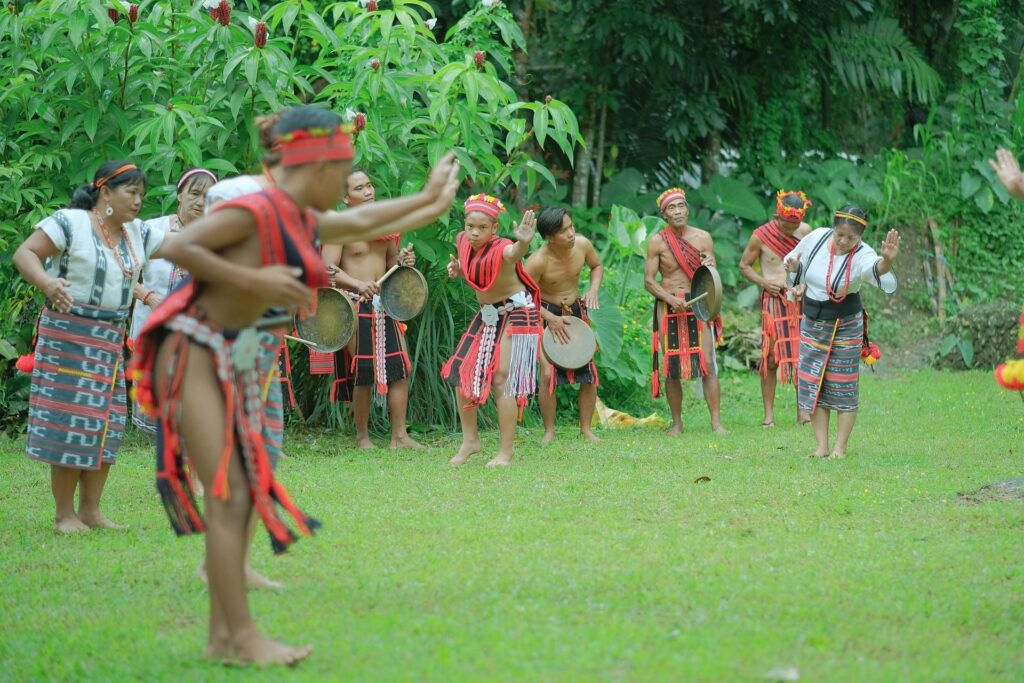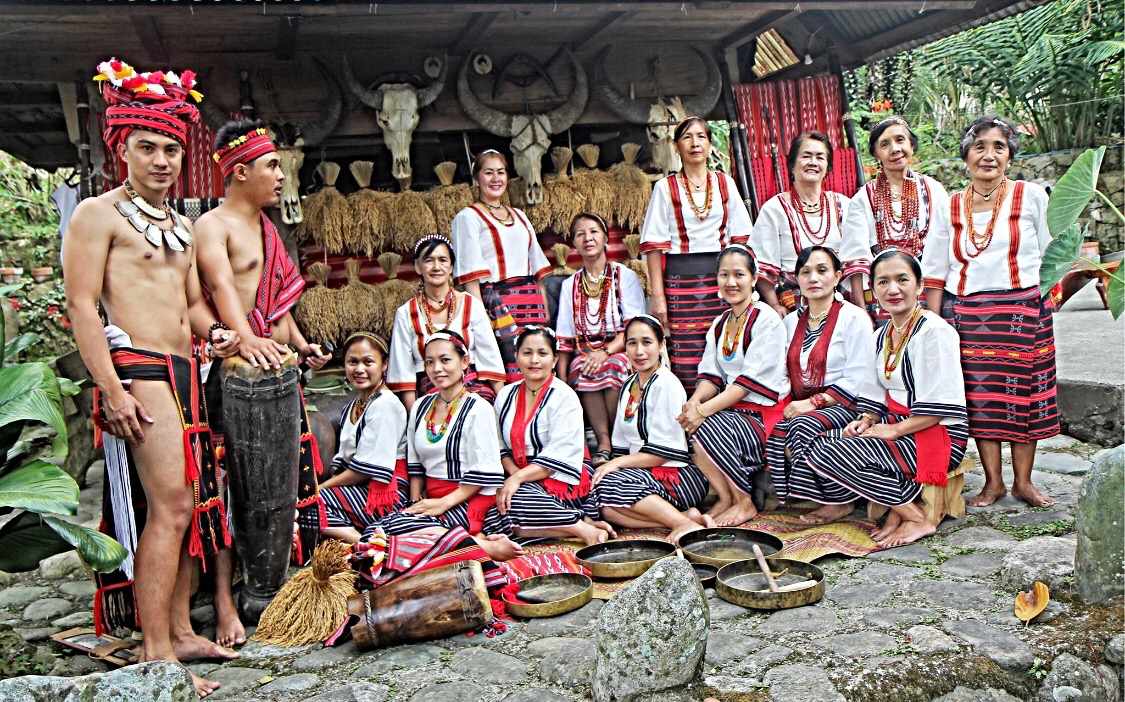IPUGO
The term Ifugao is derived from ipugo, which means “earth people”, “mortals” or “humans”, as distinguished from spirits and deities. It also means “from the hill”, as pugo means hill.
Historically, the Ifugao were renowned as headhunters, a practice that was once widespread among various tribes in the mountainous regions of northern Luzon. The bangibang dance, performed by Ifugao men adorned in traditional attire, symbolizes this martial tradition and serves as a cultural reminder of their past conflicts.
The transition from their traditional lifestyle to modernity has been gradual, marked by the influence of outside forces such as American military officers and educators in the early 20th century. Improved infrastructure like roads facilitated communication and interaction with the outside world, gradually transforming aspects of Ifugao life.
While some Ifugao continue to adhere to their ancestral customs, including wearing loincloths and chewing betel nut, many have transitioned to a more modern way of life, seeking opportunities in urban centers where jobs and economic prospects abound. This shift has led to a decline in the number of pure-blooded Ifugao and a gradual loss of traditional practices among the younger generations.
Despite these changes, the Ifugao people retain a strong sense of cultural identity, reflected in their enduring connection to their land, rituals, and heritage. They continue to serve as custodians of the magnificent rice terraces, which not only sustain their livelihood but also stand as a testament to their ingenuity and resilience throughout history.
IFUGAO CULTURE
“𝑻𝒂’𝒋𝒂𝒘” 𝑻𝒉𝒆 𝑨𝒚𝒂𝒏𝒈𝒂𝒏 𝑫𝒂𝒏𝒄𝒆


The “Tajaw” dance embodies the essence of the Ifugao tribe, reflecting their deep connection to nature and traditional way of life. It is traditionally performed on the stone walls of rice terraces, with movements rooted in their cultural beliefs and practices. Gestures such as palms facing upwards symbolize protection from evil spirits, while other movements convey humility, respect, and gratitude towards their gods and the earth. Accompanied by unique costumes and musical instruments, the dance is a captivating display of tradition and artistry.
The vibrant costumes worn by both male and female dancers enhance the visual appeal of the performance. Men wear the “wanno” or G-string along with a sash emphasizing their strength and hard work, while adorning their heads with “pongot” or headgear. Female dancers don white blouses with red-striped collars and wrap around skirts called “tapis,” showcasing intricate weaving patterns. Beaded necklaces add further adornment.


The Ayangan tribe performs the “Tajaw” on various occasions such as festivals, weddings, and funerals of elders. Depending on the event, the duration of the dance varies, with longer performances for formal gatherings and shorter intermissions for events like school activities or barangay fiestas. While traditionally associated with joyous occasions, the dance can also be performed as a respectful farewell to deceased elders, albeit by adult dancers only..

Transmission of the dance occurs through non-formal education, with elders passing down the tradition to younger generations. Mastery of the dance is showcased in cultural dance competitions at both provincial and municipal levels, demonstrating the tribe’s commitment to preserving and reviving their cultural heritage.
The “Gopah”
A “gopah” refers to an Ifugao exhortation recited at the middle of a tayo, the Ifugao native dance. Once the orator shouts, the beating of the gongs stops and the dancers stands and keep still..
Here’s a simple version:
Woooooooayyyy! (This is the first shout that stops the gongs…)
Goppagoppahan da’yun maanayottayon/ maannaldalikdik /an maannaldalipapan iya’ala papa/ Adiya’ man hintammawon/ ya adiya’ hinlang-uyawon/ Te man tinikittikid u handin matikid/ Dinayyu-dayyu’ handin madayyu/ Nangipahhada’ handin puhung/ an alyon dan numbalayan di buwayan/ amanga-mangay babana/ Itpol uy takut u ot lopto’/ Ya annakaya, hiya peman/ Balinunnuwo’ di pahul u/ Ot tuwiko’ di matana/ Hu’nuto’ di pehlet u/ ot itama’ u din hinopwa’ uy toona/ Pangiho’ di baba’gitna/ ot bangoho’/ Iyanamut uh tun lita’angan tauh tun ad ________(mentio ns a place)/ Pangidimigan hi panpanboban hi gangha/ ya pangipaypaypayadan/ hi gitgitawan di algo.
Heyyyyyyyy, duyya! (This last shout is the signal for the resumption of the beating of the gongs
“Haggiye!” is the response that would come from the dancers before the continuation of the dancing.)
Here’s a translation:
Woooooooayyyy! (This is the first shout that stops the gongs…)
I am exhorting you who graciously dances/ who slowly glides your feet on the gounds/ and stretchers your hands/ who easily catches ducks/ Don’t take me easy/ and don’t take me for granted/ for I have climbed the steep ascents/ and I have descended slopes/ until I have reached a bottom where a lake was/ which they say was home to an alligator/ feared for his protruding teeth/ But I mustered courage and dipped into the water/ And truly, there it is/ I turned my spear/ And pierced its eyes/ I pulled my hack from its scabbard/ And used it to dangle as I opened its mouth/ I pulled its feral teeth/ Placed them on my backpack/ Brought it here to our yard in ________(mentions a place)/ Our reason to beat the gongs/ and spread our hands/ At the middle of the day.
Heyyyyyyyy, duyya!
Related Articles
Ifugao and Ilocano women have traditionally worn short, tight-fitting, hand-woven skirts with colorful horizontal stripes, with a white short-sleeve blouse and a …
According to to Ifugao creation myth, the Ifugao gods created the heavens and earth way before they created man. When men were …
The Ifugao people’s religious beliefs are a complex blend of animism and Christianity, with their traditional animist beliefs intertwined with Christian teachings. …



